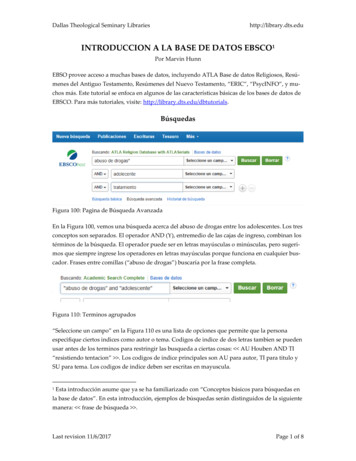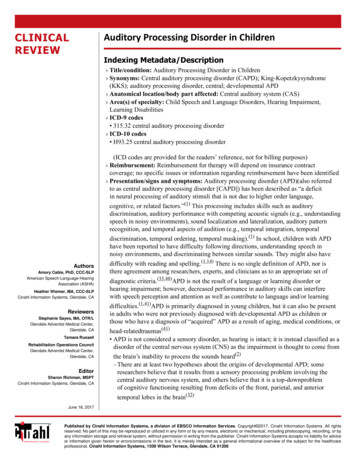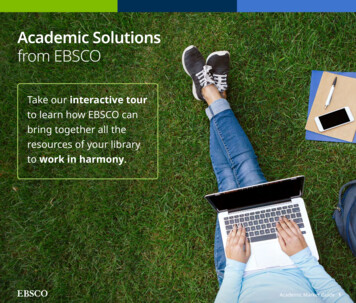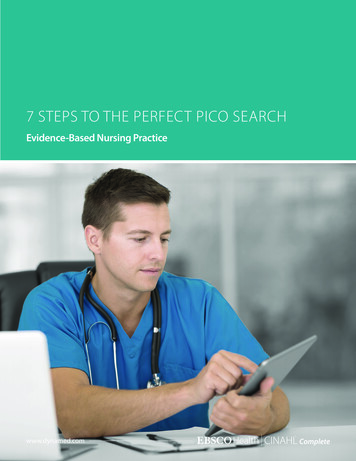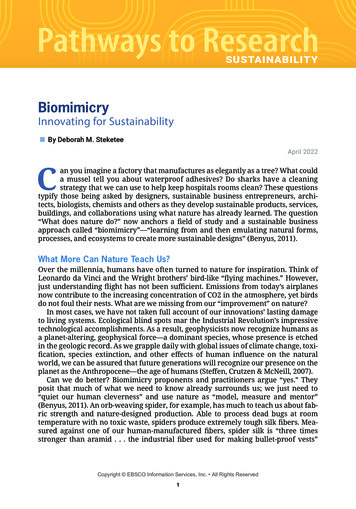
Transcription
Pathways to ResearchSUSTAINABILITYBiomimicryInnovating for SustainabilityBy Deborah M. SteketeeApril 2022Can you imagine a factory that manufactures as elegantly as a tree? What coulda mussel tell you about waterproof adhesives? Do sharks have a cleaningstrategy that we can use to help keep hospitals rooms clean? These questionstypify those being asked by designers, sustainable business entrepreneurs, architects, biologists, chemists and others as they develop sustainable products, services,buildings, and collaborations using what nature has already learned. The question“What does nature do?” now anchors a field of study and a sustainable businessapproach called “biomimicry”—“learning from and then emulating natural forms,processes, and ecosystems to create more sustainable designs” (Benyus, 2011).What More Can Nature Teach Us?Over the millennia, humans have often turned to nature for inspiration. Think ofLeonardo da Vinci and the Wright brothers’ bird-like “flying machines.” However,just understanding flight has not been sufficient. Emissions from today’s airplanesnow contribute to the increasing concentration of CO2 in the atmosphere, yet birdsdo not foul their nests. What are we missing from our “improvement” on nature?In most cases, we have not taken full account of our innovations’ lasting damageto living systems. Ecological blind spots mar the Industrial Revolution’s impressivetechnological accomplishments. As a result, geophysicists now recognize humans asa planet-altering, geophysical force—a dominant species, whose presence is etchedin the geologic record. As we grapple daily with global issues of climate change, toxification, species extinction, and other effects of human influence on the naturalworld, we can be assured that future generations will recognize our presence on theplanet as the Anthropocene—the age of humans (Steffen, Crutzen & McNeill, 2007).Can we do better? Biomimicry proponents and practitioners argue “yes.” Theyposit that much of what we need to know already surrounds us; we just need to“quiet our human cleverness” and use nature as “model, measure and mentor”(Benyus, 2011). An orb-weaving spider, for example, has much to teach us about fabric strength and nature-designed production. Able to process dead bugs at roomtemperature with no toxic waste, spiders produce extremely tough silk fibers. Measured against one of our human-manufactured fibers, spider silk is “three timesstronger than aramid . . . the industrial fiber used for making bullet-proof vests”Copyright EBSCO Information Services, Inc. All Rights Reserved1
Biomimicry: Innovating for SustainabilitySustainability(Das et al., 2015, 894). Our human-designed process for aramid? Highly engineeredand energy-intensive, with toxic inputs and outputs. Clearly, spiders do it better.A burr. This fruit attaches to animal fur via the hooks on its surface toimprove distribution. Velcro is an example of an invention which hascopied burrs and uses small flexible hooks to reversibly attach to fluffysurfaces.Zephyris, CC BY-SA 3.0, via Wikimedia Commons.Biomimicry BasicsIt was Janine Benyus’s book, Biomimicry: Innovation Inspired By Nature (1997/2002),that launched interest in bringing biology and learned lessons of the natural worldinto design and innovation processes (Kennedy et al., 2015). Proponents of biomimicry argue that nature has elegantly solved sustainability challenges over the past3.8 billion years. Those organisms with staying power have much to teach us, whilethe “failures are fossils” (Benyus, 1997/2002, 2).Embracing biomimicry— the “conscious emulation of life’s genius” (Benyus,1997/2002, 4–5)—means tapping into “nature’s recipes” for toxin-free product manufacturing, sustainable energy production, material-optimized buildings, elimination of waste and other advances. Benyus argues that humans will not survive if wecontinue to bend nature to our will; rather, we should discover our way back intonature.What makes the practice of biomimicry different from simple imitation of nature?A biomimic searches for design principles that emerge from looking at how natureCopyright EBSCO Information Services, Inc. All Rights Reserved2
Biomimicry: Innovating for SustainabilitySustainabilitydoes things. Emulation of nature adds a standard of excellence—in this case, sustainability—to how human do things. Biomimicry focuses on three general levels ofemulation: form, process, and ecosystem (Benyus, 2011; Kennedy et al., 2015; Fisch,2017). Both form and process levels relate to “nature as model” (Benyus, 1997/2002,Front Matter). At the level of form, biomimics discover an organism’s “blueprint”(Fisch, 2017, 7). For example, form may include the structure of bones, the connections of a circulatory system, or shapes on a leaf’s surface. “Production processes”encompass the second level. Understanding how the abalone makes its hard shell orhow desert beetles collect water exemplifies the work at this level.It is at the third level—that of the ecosystem—where biomimicry identifies thestrategies that anchor the idea of “nature as measure” (Benyus, 1997/2002, FrontMatter). Biomimicry specifies design principles that create “conditions conducive tolife” on Earth. These “Life’s Principles” are expressed in Biomimicy 3.8’s BiomimicryDesignLens (2015, December 11) (See Table 1).“Life’s Principles” include considerationof how organisms in nature:evolve to surviveadapt to changing conditionsare locally attuned and responsiveuse life-friendly chemistryare resource efficient (in materials and energy)integrate development with growthTable 1. “Lifes Principles”.Biomimicry 3.8 (2015, December 11). Biomimicry DesignLens: A visual guide(Version g1.1). Accessed from https:/biomimicry.net.At the ecosystem level, product innovation intersects most visibly with sustainability (Blok and Gremmen, 2016). An innovation is ethically “right” if it embodies“Life’s Principles,” which emerge from a multilevel discovery process. Inspirationleads to innovations well-suited to solve many problems at once, all the while recognizing ecosystem and planetary constraints. As noted by Kennedy et al. (2015),“When deeply informed by biology, design thinking shifts away from an anthropocentric model and considers product life cycles and earth system limitations” (p. 67).Biomimicry’s focus on “life’s principles” is mirrored in other sustainable businessframeworks such as “Cradle to Cradle” (promoted by architect William McDonoughCopyright EBSCO Information Services, Inc. All Rights Reserved3
Biomimicry: Innovating for SustainabilitySustainabilityand chemist Michael Braungart), the circular economy (Ellen MacArthur Foundation), and natural capitalism (Paul Hawken). Increasingly, biomimicry—along withthese and other frameworks—are tracking with innovation efforts in some of theworld’s leading companies.Biomimicry & Business InnovationBusinesses and industries are increasingly searching for new products and servicesin order to move closer to sustainability. By utilizing the biomimicry perspectiveand its accompanying tools, dynamic companies offering valuable nature-inspiredproducts and services have entered the marketplace. Accordingly, expertise in thefield of biomimicry is growing.Consider these examples of businesses that have prospered by tapping into nature’sgenius:Sharklet Technologies, a biotechnology company based in Aurora, Colorado, capitalizes on the characteristics of the surface of a shark’s skin (Das et al., 2015). It turnsout that shark skin effectively sloughs off bacteria and microorganisms due to the“ridges” and “ravines” (microstructures) on the skin (p. 205). Its coating product isnow used by hospitals and other organizations for high-touch surfaces wherehygienic conditions are paramount. Sharklet is also testing an application of its patented microstructure in a gel form that could be used for healing wounds.PAX Scientific founder Jay Harman studied the fluid dynamics of kelp and flowdynamics before he recognized that a familiar shape kept reappearing—the whirlpool (centripetal spiral). Using that observation, Harman’s company, founded in1997, has designed fans and propellers that build upon this insight. Centripetal spiral designs not only reduce noise but also increase efficiency, saving money for theuser, while also significantly reducing carbon usage.Interface, one of the country’s leading carpet manufacturers, offers a modularcarpet system with tiles that vary in pattern and color, just as leaves do on a forestfloor. This means carpet tiles may be installed in any direction and switched outwithout having to replace an entire carpet—saving labor and materials.Even service-oriented businesses and organizations, in general, are now findingvalue in biomimicry. Honeybee Capital Foundation (founded by Katherine Collinsand originating as Honeybee Capital) uses “cross-pollination” and other strategies todevelop new frameworks and resources for investing. Entrepreneurship is anemerging area where we may soon see explicit use of “Life’s Principles” in thinkingabout how individuals start and grow businesses (Fernhaber and Stark, 2019).Growing expertise in the field of biomimicry offers assistance to designers, engineers, entrepreneurs and others looking for biomimicry-based solutions. The Biomimicry Institute (founded by Janine Benyus and Bryany Schawn) offers certifications and resources for individuals who are interested in becoming biomimics.Biomimicry 3.8, the institute’s related consultancy, guides businesses as they embarkon nature-inspired solutions for product, process, and other areas of innovation.Biomimicry for Social Innovation offers a platform for those interested in exploringnature’s organizational design and leadership strategies.Copyright EBSCO Information Services, Inc. All Rights Reserved4
Biomimicry: Innovating for SustainabilitySustainabilityDermal denticles of a lemon shark viewed through a scanning electronmicroscope.Pascal Deynat/Odontobase, CC BY-SA 3.0, via Wikimedia Commons.Biomimicry is also growing as a field of study. The University of Akron hosts aBiomimicry Research and Innovation Center that supports a PhD program. Studentscan focus their studies and hone their expertise in biomimicry by working in schoolsand companies while at the same time conducting research in traditional academicresearch laboratories. Meanwhile, Arizona State University offers online Master’sdegree and certificate programs in biomimicry. Finally, AskNature.org, a databasedeveloped through the contributions of biologists and the organisms whose storiesare told there, provides a valuable starting point for innovation that everyone canuse.Critiques of BiomimicryBiomimicry serves as an innovation approach but also resonates with some as abasis for hope in the Anthropocene, taking form as a “rising popular ecology movement” (Fisch, 2017, p. 1). Yet, critiques have surfaced about biomimicry’s possiblecontributions.In examining the intersection of biomimicry and innovation for sustainability,Kennedy et al. (2015) argue that “biomimicry does not necessarily render sustainable outcomes” (p. 69). This limitation surfaces when research only focuses on formand process of an organism while failing to take measure of “Life’s Principles” at theecosystem level. For example, various military applications use “swarm” theory butmay offer pause in terms of “supporting conditions conducive to life” (Biomimicry3.8, 2015).Another critique, put forward by anthropologist Michael Fisch, emphasizes thatBenyus’s conception of “biomimicry as a science of nature” reinforces a separationCopyright EBSCO Information Services, Inc. All Rights Reserved5
Biomimicry: Innovating for SustainabilitySustainabilitybetween technology and nature. This positioning touts nature as something to beused in a different way, but still for the benefit of one species—humans (Fisch, 2017,5). Blok and Gremmen (2016) also critically examine biomimicry’s conceptualizationof nature, identifying biomimicry as a technology that needs to be transferred tohumans. Noting the ambiguity between nature and technology, Blok and Gremmenstate that:Given the claim of the proponents of biomimicry that it entails anew [emphasis in original] approach to technology and innovationthat is embedded in nature [emphasis in original] and in harmony withthe natural ecosystems of planet earth, it is at least striking that themimicking of nature is in fact mimicking a technological model ofnature. (206)ConclusionBiomimicry offers us a revolutionary approach to how we make things. It may alsohelp us solve pressing challenges for humanity. As a relatively new field, it has manyproofs-of-concept that are paying off for business, consumers, and community. Itstrue promise, however, rests in its ability to open our minds to time-tested possibilities for survival.ReferencesBenyus, J. (2016, December 15). A biomimicry primer. AskNature.org. Retrieved fromhttps://asknature.org/.Benyus, J. (1997/2002). Biomimicry: Innovation inspired by nature. NewYork: HarperPerennial.Biomimicry 3.8 (2015, December 11). Biomimicry DesignLens: A visual guide (Version g1.1). Retrieved from https://biomimicry.net/Blok, V. & Gremmen, B. (2016). Ecological innovation: Biomimicry as a new way ofthinking and acting ecologically. Journal of Agricultural and Environmental Ethics,29, 203–217. doi:10.1007/s10806-015-9596-1Das, S., Bhowmick, M., Chattopadhyay, S.K., & Basak, S. (2015). Application of biomimicry in textiles. Current Science, 109(5), 893–901. doi10.18520/v109/i5/893-901Fernhaber, S.A. and Stark, A.Y. (2019). Biomimicry: New insights for entrepreneurship scholarship. Journal of Business Venturing Insights, 12, e00137.Fisch, M. (2017). The nature of biomimicry: Toward a novel technological culture.Science, Technology & Human Values, 42(5), 795–821. doi:10.1177/0162243916689599Kennedy, E., Fecheyr-Lippens, D., Hsiung, B., Niewiarowski, P.H., & Kolodziej, M.(2015). Biomimicry: A path to sustainable innovation. DesignIssues 31(3), 66–73.doi:10.1162/DESI a 00339Copyright EBSCO Information Services, Inc. All Rights Reserved6
Biomimicry: Innovating for SustainabilitySustainabilitySteffen, W., Persson, A., Deutsch, L., Zalasiewicz, J., Williams, M., Richardson, K., &Svedin, U. (2011). The Anthropocene: From global change to planetary stewardship. AMBIO-A Journal of the Human Environment 40, 739–761. doi:10.1007/s13280011-0185-xFurther ReadingAppio, F.P., Achiche, S., Martini, A. & Beaudry, C. (2017). On designers’ use of biomimicry tools during the new product development process: An empirical investigation. Technology Analysis & Strategic Management 29(7), 775–789. doi:10.1080/09537325.2016.1236190.BBC World Service (2020). 30 Animals that made us smarter (Podcast). Retrievedfrom /downloads.Biomimicry Institute. (2018). Ask Nature [Biomimicry database]. Retrieved fromhttps://asknature.org/.Bockholt, M. T., Kristensen, J. H., Wæhrens, B. V., & Evans, S. (2019, December). Learning from the nature: enabling the transition towards circular economy throughbiomimicry. In 2019 IEEE International Conference on Industrial Engineering andEngineering Management (IEEM) (pp. 870-875). IEEE.Bragdon, J. H. (2021). Economies that mimic life: From biomimicry to sustainable prosperity. Oxfordshire, UK: Routledge.Collins, Katherine. (2014). The nature of investing: Resilient investment strategiesthrough biomimicry. Brookline, MA: Bibliomotion.Cherny-Scanlon, X. (2014, July 29). Seven fabrics inspired by nature: From the lotusleaf to butterflies to sharks. The Guardian. Retrieved from https://www.theguardian.com/.DiCaprio, G., Peled, R.S. & Factor, S. (Executive Producers). Benyus, J. (Narrator).(2015). Biomimicry [Online video]. Tree Media. Retrieved from https://www.treemedia.com/biomimicry.Harman, Jay. (2013). The shark’s paintbrush: Biomimicry and how nature is inspiringinnovation. Ashland, OR: White Cloud Press.Kennedy, E.B. & Marting, T.A. (2016). Biomimicry: Streamlining the front end of innovation for environmentally sustainable products. Research-Technology Management 59(4), 40–47. doi:10.1080/08956308.2016.1185342.Volstad, N. L. & Boks, C. (2012). On the use of biomimicry as a useful tool for the industrial designer. Sustainable Development 20, 189–199. doi:10.1002.sd.1535.Weerasinghe, D., Perera, S., & Dissanayake, D. (2019). Application of biomimicryfor sustainable functionalization of textiles: review of current status and prospectus. Textile Research Journal 89(19–20), 4282–4294. https://doi.org/10.1177/0040517518821911.Copyright EBSCO Information Services, Inc. All Rights Reserved7
Biomimicry: Innovating for SustainabilitySustainabilityAbout the AuthorDeborah M. Steketee, PhD, serves as Department Chairperson and Professor of SustainableBusiness at Aquinas College. In addition to teaching, she led the Center for Sustainability atAquinas College as its Executive Director from 2006–13. In 2016, Dr. Steketee was inductedinto the West Michigan Sustainable Business Hall of Fame. Dr. Steketee earned a BA in journalism from the University of Michigan, a MSc in Resource Development from MichiganState University, and a PhD in Public Policy and Political Science from Indiana UniversityBloomington, focusing her research on the social dimensions of natural resources management.Copyright EBSCO Information Services, Inc. All Rights Reserved8
tion), and natural capitalism (Paul Hawken). Increasingly, biomimicry—along with these and other frameworks—are tracking with innovation efforts in some of the world's leading companies. Biomimicry & Business Innovation Businesses and industries are increasingly searching for new products and services in order to move closer to .
